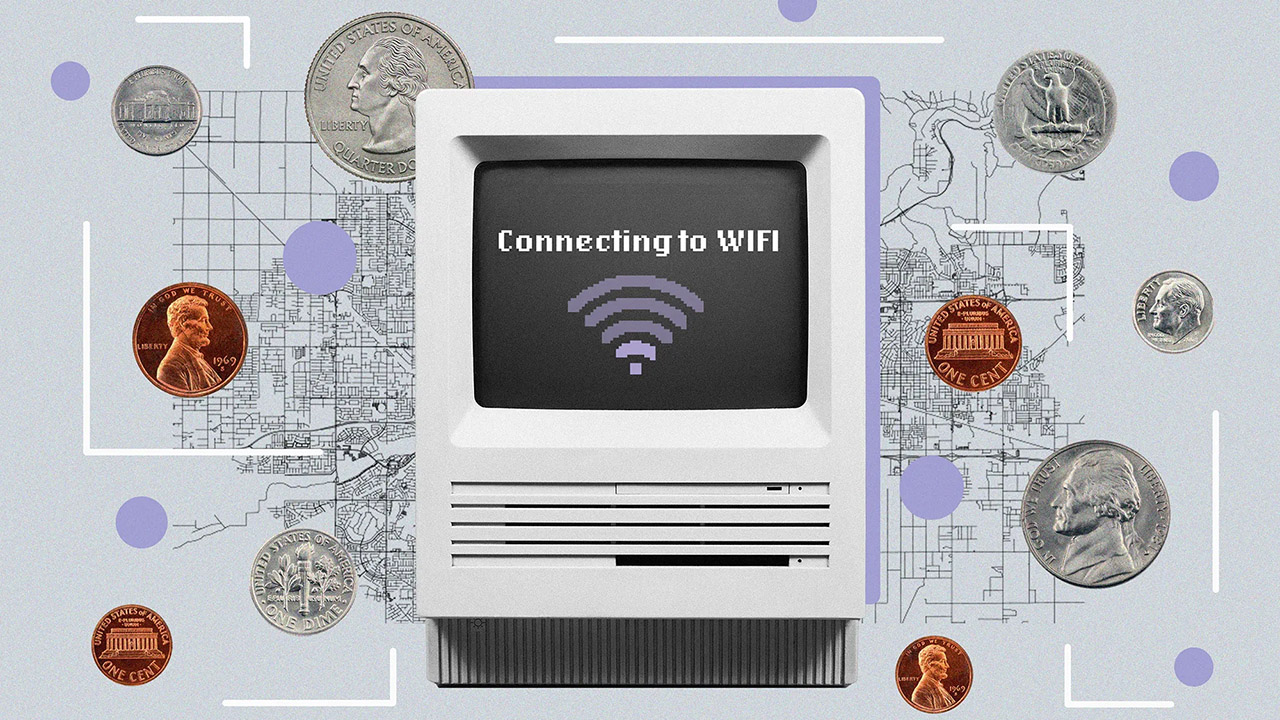Nearly $2 billion in broadband funding is at stake in the next 30 days, but advocacy groups say the challenge process is designed to fail. (CalMatters/Adriana Heldiz)

- The challenge process for map changes, which determines funding distribution, is seen as arduous and potentially flawed.
- Advocacy groups argue that the data used to compile the maps is inaccurate, leading to potential misallocation of funds.
- The challenge process is limited to certain parties, making it difficult for individuals to have their internet access issues recognized.
Share
|
Getting your Trinity Audio player ready...
|
Starting next week, California residents have 30 days to challenge maps that will determine how $1.8 billion is distributed to increase internet access in the state.

Khari Johnson
CalMatters
Actually getting the California Public Utilities Commission to accept changes to the federal maps is quite difficult, which internet access advocates with educational backgrounds are raising alarm over.
For example, after the COVID-19 pandemic hit and teachers at the Fresno Unified School District started teaching classes remotely, Philip Neufeld started work to ensure 7,000 students could log on.
Neufeld, a district IT worker and member of the Fresno Coalition for Digital Inclusion, started noticing patterns. He heard about students going to Taco Bell and McDonald’s for WiFi to do their homework, but he saw comparatively low download speeds across entire neighborhoods, disparities that reminded him of redlining, the practice of denying people housing and wealth based on their race. Neufeld and a colleague built an open source tool to gather 14 million speed tests across Fresno over the span of two years.
“What it shows is that it’s not just people in rural areas who have a real need for better internet,” he said. “It’s people in urban, low-income neighborhoods in apartment buildings and mobile home parks, and these patterns are showing up across multiple large cities that have higher poverty.”
Data collected from students in Fresno mirrors “digital redlining” documented in other parts of the United States. But the government won’t use data like the kind collected in Fresno to redraw a map that will decide how to distribute the money because Neufeld’s data doesn’t conform precisely to the strict challenge process that’s been put in place. That’s one of a number of ways advocacy groups say the process to challenge how funding for affordable high-speed internet is difficult. Some advocates have gone so far as to suggest the challenge process is broken by design.
Related Story: California Budgets up to $12 Million for Reparations Bills, a Milestone in ...
‘Once in a Century’ Broadband Funding
Shortly after the COVID-19 pandemic exposed areas of the digital divide — the gap between people with ready access to reliable internet and those who don’t — for students and workers, Congress passed an infrastructure bill in 2021 to invest more than $42 billion in broadband internet projects in all 50 U.S. states and six territories. California got $1.8 billion for such projects. A U.S. Department of Commerce agency oversees the program and the California Public Utilities Commission distributes the money to local projects.
Government officials and advocates alike refer to the Broadband Equity Access and Deployment, or BEAD program, as a once in a generation or, as a contractor working with the California Public Utilities Commission put it, a “once in a century” investment in affordable high-speed internet access.
But advocates say maps compiled with data provided by internet service providers are highly inaccurate while the challenge process is short, arduous, and unfairly places the burden of proving that inaccuracy on people in areas unserved or underserved. They warn this could lead to the once in a generation money being misspent.
How to Challenge Government Internet Access Maps
Anyone can visit a state online portal to find out if their home or nearby community institutions are designated as eligible for funding, or if the map inaccurately says they have internet access or adequate internet speed. They can use the same portal to run tests to challenge things about their home internet like speed or latency. Successful challenges can change a home designation, but there’s no guarantee that the challenge will make a difference because only certain parties can challenge the maps.
Only local and tribal governments, internet service providers, and advocacy groups can demand changes to the map, and so in order for an individual who challenges claims about their internet access to be heard, one of these groups must verify the evidence gathered by an individual and claim their challenge in order for it to be recognized by state and federal agencies.
Among more than 80 such organizations registered to participate in the challenge process, roughly two dozen are municipal, county, or tribal governments.
To successfully challenge internet speeds, an individual must carry out speed tests three times a day over the span of three days and provide details. They must also subscribe to a broadband speed plan or the highest tier plan available from an internet service provider.
“What it shows is that it’s not just people in rural areas who have a real need for better internet.”
PHILIP NEUFELD, IT WORKER, FRESNO UNIFIED SCHOOL DISTRICT
Inspired by Neufeld, Oakland Undivided did a similar speed test in late 2023 in partnership with the Oakland Unified School District and HubbleIQ. There they found that more than half of 18,000 students had download speeds that would qualify for BEAD funding and heat map patterns that resemble historical redlining. Speeds are 10 times better in high income neighborhoods in the area serviced by AT&T, Comcast, Sonic, and T-Mobile, but the FCC map shows that adequate coverage is nearly ubiquitous throughout the city of Oakland.
“We’ve been talking with a lot of other digital equity coalitions around the state in Fresno, LA, and we kind of all agree that this process is designed to make it impossible for communities to submit data,” said Patrick Messac, director of Oakland Undivided, a nonprofit organization started during the COVID-19 pandemic that last year critiqued a map for distributing billions of dollars for a state broadband program.
Related Story: California Legislature Makes a Flurry of Big Changes to November Ballot
Because of the difficulty involved with collecting speed test data, Oakland Undivided changed focus from speed tests and the challenge process to instead seek greater internet availability for community institutions. But Messac, who also works in IT for the city of Oakland, worries that the federal broadband dollars could get depleted before places like schools, libraries, and Head Start centers would be in line for funding.
“What we are finding, and others have noted as well, is that the National Map overstates coverage,” said Adeyinka Ogunlegan, the vice president of government affairs and policy for EducationSuperhighway.
That group is focused on improving internet speeds in apartment buildings since roughly 1 in 4 people who lack internet access live there. It’s one of the only organizations nationwide planning to mount challenges in all 50 U.S. states, with 800 planned challenges in California alone. EducationSuperhighway is also choosing to focus on availability challenges instead of speed tests. Ogunlegan wouldn’t go so far as to say the challenge process is designed to fail, but said it’s difficult for organized groups that have followed the process for years to participate, so it must be challenging for the average individual as well. Making people call internet service providers instead of using an online tool, for example, makes it harder to gather evidence that an internet provider does not offer services at your address.
John Windhausen is executive director of Schools, Health, and Libraries Broadband Coalition, a nonprofit organization with hundreds of member groups. He’s hearing from members that the challenge process is very difficult.
“We are concerned that internet service providers allege that they serve areas but many locations cannot receive the level of service required by the BEAD program,” he said.
Alexis Schrubbe is director of the Internet Equity Initiative at the University of Chicago and a member of the National Broadband Mapping Coalition. She helped make an open source tool for residents to carry out speed tests and agrees with other broadband experts who say the map for allocating the federal funding overstates coverage. She encourages anyone dissatisfied with their internet to mount a challenge and take the opportunity to participate. It can seem like a lot of labor but it’s really not for a once-in-a-lifetime chance.
“This is everybody’s best chance to have their complaint heard, so they should take advantage of it,” she said. “Don’t be afraid to ask questions, and don’t be intimidated by the process. It’s our best chance to make the maps right and to stand up and advocate for ourselves.”
‘(California) Should Be a Leader in This Space’
The challenge process for the federal money in California begins July 3 and ends Aug. 5. After the public submits challenges to the map, internet service providers get their chance to rebut those challenges. The California Public Utilities Commission expects to make final determinations by the end of the year.
Initiatives to narrow the digital divide started to backslide in recent months with the loss of the federal Affordable Connectivity Program subsidy in April.
In more positive news, 10 affordable broadband projects received initial approval last week. The public utilities commission is slated to make a final decision with a vote in August. Also last week: the Federal Communications Commission said it plans to modernize its E-Rate program. A change, if adopted at a July 18 meeting, would allow more schools access to funding to loan students Wi-Fi hotspots for use at home.
Both internet service providers and groups passionate about ending the digital divide are campaigning for AB 2239, a draft bill that defines digital discrimination to broadband internet access and allows city attorneys and district attorneys to file suit against internet service providers.
However the challenge process turns out, Neufeld wants state education groups to continue to routinely run speed tests on devices loaned to students. If anonymized and made into a formal process, the tests could inform broadband investments or prove patterns of neglect that can lead to legal action under AB 2239 in order to hold internet service providers to account.
“We [California] should be a leader in this space,” he said. “There’s no reason at a state level that we couldn’t have a better way of mapping users’ real experience.”
About the Author
Khari Johnson is part of the economy team and is CalMatters’ first tech reporter.
About CalMatters
CalMatters is a nonprofit, nonpartisan newsroom committed to explaining California policy and politics.
RELATED TOPICS:
Categories




















